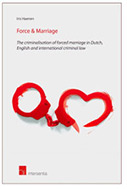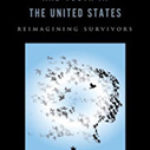Force & Marriage: The Criminalisation of Forced Marriage in Dutch, English and International Criminal Law

Author: Iris Haenen
Publisher: Cambridge, UK: Intersentia, 2014. 403p.
Reviewer: Khatidja Chantler | November 2015
Force and Marriage is an authoritative text that explicates in detail the issue of forced marriage and its treatment in international criminal law and in national law in the Netherlands and England. The book is organised in four parts. Part I gives a description and definition of forced marriage; Part II considers criminalisation at the national level and international level; Part III discusses the legal frameworks concerning forced marriage in Dutch, English and International criminal law and Part IV provides an analysis of whether forced marriage should be criminalised at an international level and whether it constitutes a distinct war crime, crime against humanity or a genocidal act. Part IV also discusses whether or not forced marriage should be criminalised in Dutch Law.
Part I starts with a description and definition of marriage and adopts an inclusive definition of marriage including same sex couples. The book also makes the point that forced marriage has taken place in a wide range of cultures including Euro-American cultures. It would, however, have been useful to explore the relationship between poverty and forced marriage as international studies demonstrate that poverty is a strong predictor for forced marriage, with the poorest countries in the world having the highest incidence of early and forced marriage.
Forced marriage is known to be difficult to define in the research and policy literature despite Article 16 of the Universal Declaration of Human Rights, which highlights consent as central to the right to marry ‘with the full and free consent of the intending spouses.’ The author stresses that forced marriage needs to be conceptualized as coercion to marry at the point of entry into marriage as well as the state of being in the (forced) marriage where exit options are limited. To illustrate this, the author draws on a range of well-known international situations to discuss whether for example, ‘bush-wives’ in the Sierra Leonean context constitute forced marriage.
Chapter 3 discusses forced marriage in conflict situations, and detailed descriptions and analysis is offered of Sierra Leone and Cambodia which is illuminating and helpful as it compares and contrasts two very different arenas of potential forced marriage. Numerous examples of forced marriage in conflict situations in other countries are touched upon, but without the detailed analysis offered for Cambodia and Sierra Leone.
Part II engages with the central issue of the book – should forced marriage be criminalized, and importantly, how should this decision be reached, both at a national level and an international level? In Chapter 4, the author recognises the highly politicised nature of criminalization, but goes on to utilise established criteria used in decision-making about whether or not to introduce a new criminal violation. Two primary criteria (harm and wrongfulness) and four secondary criteria (proportionality, subsidiarity, effectiveness and legality) are used as the framework for analysis. Taken together, these represent a minimalist approach to criminalisation. Part II (Chapter 5) then considers the framework for whether forced marriage should be criminalised at an international level. The International Criminal Court (ICC) only has jurisdiction over those crimes codified in the Rome Statute. Hence, to answer the question of whether forced marriage should be criminalised as a specific offence, consideration needs to be given to whether forced marriage constitutes a crime against humanity, whether it is a war crime and/or an act of genocide. The chapter rightly points out that international criminal law has developed on an ad hoc basis as it responds to new crises and atrocities. Importantly, as the author discusses, this means that international criminal law does not have the rich doctrinal tradition of national law making. In Chapter 6, the author compares the doctrinal traditions of national law–making to the international context and argues that this offers opportunities for cross-fertilization between and across the two domains. She concludes that rather than seeing national and international criminalization as separate entities, it is more helpful to see the overlaps between the two despite their different traditions and the requirement for consensus amongst different nations for international criminalization. Haenen argues that ‘national’ criteria are also evident at the international level, as international criminalisation also includes the criteria of wrongfulness, harm, internal subsidiarity and legality. Issues of external subsidiarity and proportionality are not explicit in international criminalization as they are inherent within the higher threshold applied for wrongfulness and harm. However, this comparison merited a more in-depth treatment given the complexity of the task.
Part III explores the specific legal frameworks pertaining to Dutch, English and international criminal law in relation to forced marriage. It is not very clear why another level of detailed comparison is undertaken in Chapter 7, although the author highlights that the more intense public debate, policy and developing framework in England provide a strong rationale for such a comparison. The legal frameworks in the two countries are different, and in the UK forced marriage has been made a specific criminal offence in the Anti-Social Behaviour, Crime and Policing Act 2014. There are also civil measures (Forced Marriage (Civil Protection) Act) designed to help prevent a forced marriage from taking place as well as offering a means of escape once the marriage has taken place. Civil measures are considered by many of those working with victims of forced marriage to be sufficient in terms of legal redress. The criminalization of forced marriage in England is primarily a means of sending a strong negative message to communities in which forced marriage is practised. In contrast, in the Netherlands, there has been little debate about criminalization of forced marriage and forced marriage is not a specific criminal offence. However, existing criminal offences were strengthened to deal with forced marriage, specifically the Marital Coercion (criminal law) Act 2013 which includes increasing the maximum statutory penalty for coercion and broadening the extraterritorial jurisdiction of Dutch criminal courts to include Dutch nationals who have been coerced into marriage abroad. In the Dutch context, the central premise of full and free consent to marry is not enshrined in law as it is assumed that this is common knowledge, but there are a number of civil law remedies where forced marriage is threatened or has already taken place. Annulment is one option and the Marital Coercion (civil law) Bill recognises that any forms of coercion (e.g. physical or more subtle psychological pressure) are eligible grounds for annulment. This chapter gives a detailed description of available legal remedies in both countries and also offers some analysis of the debates on criminalization in England.
The author then goes on to consider international criminalization and forced marriage in Chapter 8 which focusses specifically on the proceedings of the Special Court for Sierra Leone (SCSL). The case law emerging from the SCSL is messy and contradictory, but is nevertheless significant, as it ruled in 2004 that the phenomenon of ‘bush wives’ constituted forced marriage and was not adequately covered by the existing crimes against humanity, a war crime or an act of genocide. A landmark decision was made by the SCSL to include forced marriage as a new offence under ‘other inhumane acts’ (Article 2(i) SCSL statute) thus paving the way for the first time for international criminalization of forced marriage as a distinct crime against humanity. However, as the author points out there are several difficulties with this decision, as the definition of forced marriage is ambiguous and the issue of whether forced marriage can be subsumed under the crime of sexual slavery is a moot point. There is a less detailed treatment of the case law of the Extraordinary Chambers in the courts of Cambodia and the chapter might have benefited from sticking to the SCSL proceedings.
Chapter 9 provides a two-level legal comparison between England and the Netherlands re forced marriage in the first part of the chapter; the second part then compares these national frameworks with international frameworks. Here there appears to be a fair amount of repetition of key arguments. However, it illustrates the many similarities between Dutch and English laws despite these national frameworks appearing to have little in common at face value. The national/international comparison is tricky as the author herself acknowledges given their different doctrinal traditions and the reactiveness of international criminalization. The key take home point here is that there are no civil measures to protect against forced marriage at an international level.
Part IV consists of Chapter 10 and a summary. It provides a response to the central question of the book of whether forced marriage should be criminalised as a distinct offence in Dutch criminal law and in international criminal law. It uses the principles detailed in Chapters 4 and 5 as an analytic tool to respond to the core question of the book. Using these principles, the author concludes that there is no requirement for a distinct criminal offence of forced marriage in the Netherlands or at the international level.
This book makes a significant contribution to knowledge and has a methodical and thorough approach with many chapters providing detailed description and rich analysis. If anything, its scope is possibly too ambitious so that on occasion the multi-level comparisons do not quite work. The structure generally works well, and although repetitive in parts, the repetition is important for the attention to detail required for the topic.
Dr Khatidja Chantler,
Reader,
School of Social Work,
Room 324, Harrington Building,
University of Central Lancashire


